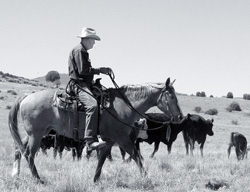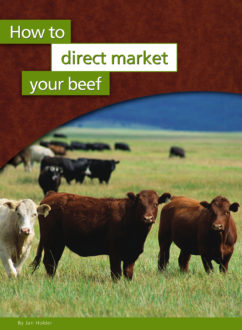
Unlike marketing your cattle conventionally and selling everything on one day, direct marketing your beef will cause you to have to deliver cattle several times a year.
It can be trickier than you might think. If you are doing farmers markets, it is not so critical if you don’t have beef to sell at every market (other than lost opportunity). However, if you are selling to stores and restaurants, you cannot ever run short. They will be willing to work with you from time to time, but if it becomes a habit, they’ll stop buying from you. In fact, that will probably be your biggest stumbling block to selling to restaurants and stores – earning their trust that you won’t ever come up short.
If you’ve done your planning homework, you should be able to predict your demand close enough not to cause any major problems. Stores and restaurants have a very good idea of how your product will do with their customers. Be sure to flat out ask them what your sales volume might be, listen and respect their advice. We also make it a rule to have a major new client one full year before adding additional clients, so that we get a good feel for their demand cycles.
Choosing how to schedule your cattle production is important from a marketing perspective. Most urban customers are conditioned for convenience – they are used to buying tomatoes 365 days per year, rather than late summer when the tomatoes are ripe on the vine in our part of the world. This same thinking applies to cattle as well. Most urban customers do not realize that it takes two years to grow out beef, or that cattle only finish well during a certain part of the year.
It will be your job to either educate your customers about time and seasonal restraints, or develop a “pipeline” that will satisfy their need for the convenience of having grass-fed beef available 24/7.
There are basically only three ways to sell beef: 1) feedlot, 2) seasonally, and 3) frozen. Of course there could even be variations or combinations of these three ways, but how you schedule your cattle will depend a lot on which way you choose.
The most forgiving of these three is frozen. Your frozen storage is your pipeline. You can theoretically finish all your beef in three months, throw it all in a freezer, and then sell it all year long. Of course there is some cost with this, and that needs to be figured into the equation. It also allows you to keep a cushion that will smooth out the bumps between supply and demand, or when bringing on a new customer.
We’ve never run a feedlot, but it seems to be the second easiest way. A lot is also a pipe-line. The hard part is buying the right weights at the right time of year to feed your demand. To do this, you will either have to develop multiple breeding seasons, or buy from a large geographical area where folks don’t all calve at the same time. You also don’t have to plan so far in advance with a feedlot. Because more of your cattle will finish within a year, you can move and make changes faster. In a grass-fed program, it takes two years to finish an animal.
Finally, a seasonal product is hardest, at least from a scheduling point of view. It also has a lot of advantages in that your cattle are out on the pasture earning you money, instead of taking money eating bought feed or paying rent for frozen storage. However, you will have to stair-step your cattle to finish throughout the season. It’s a pretty hard task in itself, not even considering all the other elements that can frustrate you: differing rates of gain, sickness, drought, demand surges, predator kills, carcass variability and mechanical breakdowns at the slaughter house (even though the processing has stopped, your cattle are still going). With a seasonal pro-gram, once you get behind, things snowball fast and it’s almost impossible to catch up.
